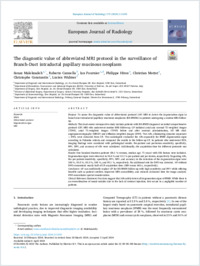The diagnostic value of abbreviated MRI protocol in the surveillance of Branch-Duct intraductal papillary mucinous neoplasm
DOKPE
- Malekzadeh, Sonaz Sion Hospital, Switzerland
- Cannella, Roberto University of Palermo, Italy
- Fournier, Ian Geneva University Hospitals, Switzerland
- Hiroz, Philippe Sion Hospital, Switzerland
- Mottet, Christian Sion Hospital, Switzerland
- Constantin, Christophe Sion Hospital, Switzerland
- Widmer, Lucien ORCID University of Fribourg
- 2024
Published in:
- European Journal of Radiology (EJR). - Amsterdam : Elsevier B.V.. - 2024, vol. 175, p. 1-8
English
Purpose: To assess the diagnostic value of abbreviated protocol (AP) MRI to detect the degeneration signs in branch-duct intraductal papillary mucinous neoplasms (BD-IPMNs) in patients undergoing a routine MRI follow-up.
Methods: This dual-center retrospective study include patients with BD-IPMN diagnosed on initial comprehensive protocol (CP) MRI who underwent routine MRI follow-up. CP included axial and coronal T2-weighted images (T2WI), axial T1-weighted images (T1WI) before and after contrast administration, 3D MR cholangiopancreatography (MRCP) and diffusion-weighted images (DWI). Two APs, eliminating dynamic sequences ± DWI, were extracted from CP. Two radiologists evaluated the APs separately for IPMN degeneration signs according to Fukuoka criteria and compared the results to the follow-up CP. In patients who underwent EUS, imaging findings were correlated with pathological results. Per-patient and per-lesion sensitivity, specificity, PPV, NPV, and accuracy of APs were calculated. Additionally, the acquisition time for different protocols was calculated.
Results: One hundred-fourteen patients (56.1 % women, median age: 71 years) with 256 lesions were included. Degeneration signs were observed in 24.6 % and 12.1 % per-patient and per-lesion, respectively. Regarding APs, the per patient sensitivity, specificity, PPV, NPV, and accuracy in the detection of the degeneration signs were 100 %, 93.5 %, 83.3 %, 100 %, and 95.1 %, respectively. No additional role for DWI was detected. AP without DWI economized nearly half of CP acquisition time (388 versus 663 s, respectively).
Conclusion: AP can confidently replace CP for BD-IPMN follow-up with high sensitivity and PPV while offering benefits such as patient comfort, improved MRI accessibility, and reduced dedicated time for image analysis. DWI necessitates special consideration.
Clinical Relevance Statement: Our data suggest that APs safely detect all degeneration signs of IPMN. While there is an overestimation of mural nodules due to the lack of contrast injection, this occurs in a negligible number of patients.
Methods: This dual-center retrospective study include patients with BD-IPMN diagnosed on initial comprehensive protocol (CP) MRI who underwent routine MRI follow-up. CP included axial and coronal T2-weighted images (T2WI), axial T1-weighted images (T1WI) before and after contrast administration, 3D MR cholangiopancreatography (MRCP) and diffusion-weighted images (DWI). Two APs, eliminating dynamic sequences ± DWI, were extracted from CP. Two radiologists evaluated the APs separately for IPMN degeneration signs according to Fukuoka criteria and compared the results to the follow-up CP. In patients who underwent EUS, imaging findings were correlated with pathological results. Per-patient and per-lesion sensitivity, specificity, PPV, NPV, and accuracy of APs were calculated. Additionally, the acquisition time for different protocols was calculated.
Results: One hundred-fourteen patients (56.1 % women, median age: 71 years) with 256 lesions were included. Degeneration signs were observed in 24.6 % and 12.1 % per-patient and per-lesion, respectively. Regarding APs, the per patient sensitivity, specificity, PPV, NPV, and accuracy in the detection of the degeneration signs were 100 %, 93.5 %, 83.3 %, 100 %, and 95.1 %, respectively. No additional role for DWI was detected. AP without DWI economized nearly half of CP acquisition time (388 versus 663 s, respectively).
Conclusion: AP can confidently replace CP for BD-IPMN follow-up with high sensitivity and PPV while offering benefits such as patient comfort, improved MRI accessibility, and reduced dedicated time for image analysis. DWI necessitates special consideration.
Clinical Relevance Statement: Our data suggest that APs safely detect all degeneration signs of IPMN. While there is an overestimation of mural nodules due to the lack of contrast injection, this occurs in a negligible number of patients.
- Faculty
- Faculté des sciences et de médecine
- Department
- Département de Médecine
- Language
-
- English
- Classification
- Pathology, clinical medicine
- License
- Open access status
- hybrid
- Identifiers
-
- DOI 10.1016/j.ejrad.2024.111455
- ISSN 0720-048X
- Persistent URL
- https://folia.unifr.ch/unifr/documents/328433
Statistics
Document views: 52
File downloads:
- 1-s2.0-s0720048x24001712-main: 157
